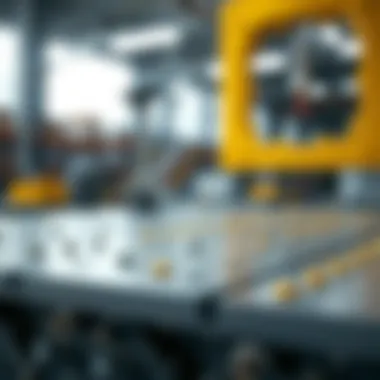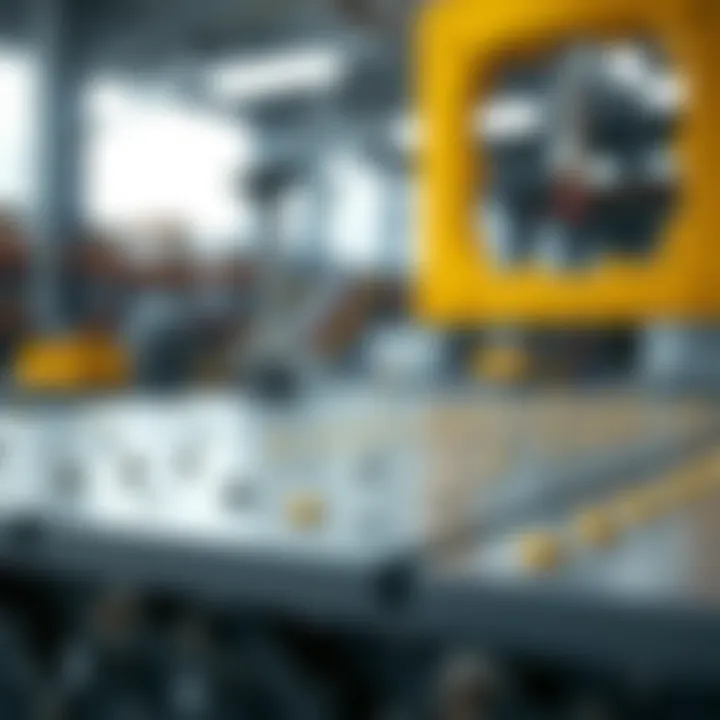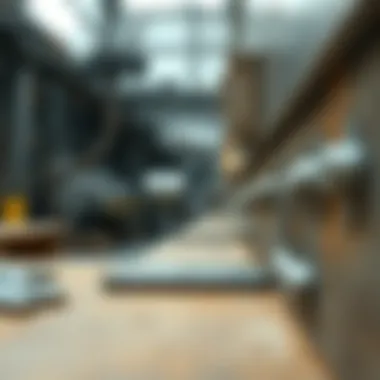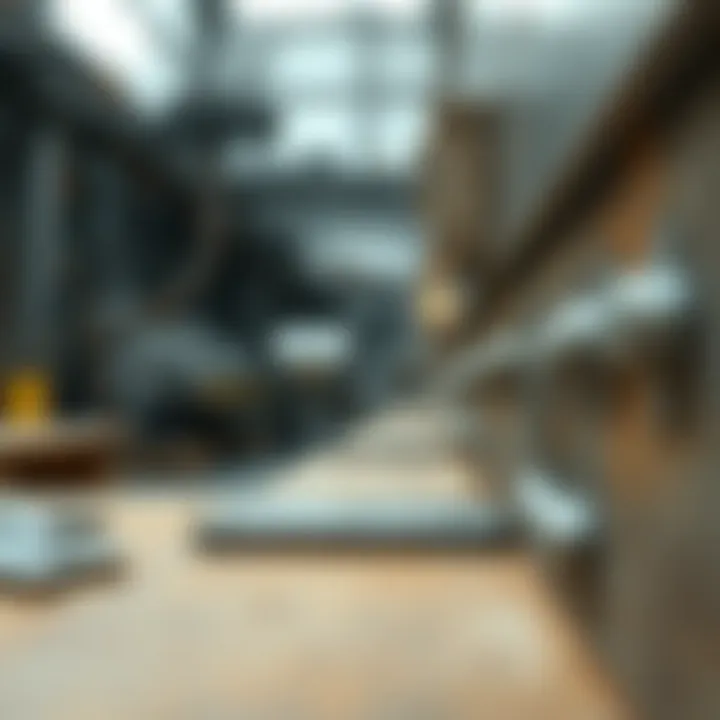Metal Shims in Foundation Engineering: Key Insights


Intro
In the world of foundation engineering, the often overlooked yet crucial elements are metal shims. These small, yet mighty materials play a significant role in ensuring the stability and integrity of various structures. Whether it's a skyscraper scraping the sky or a humble residential building, metal shims serve essential purposes by bridging gaps and leveling foundations. This article delves deep into the applications and considerations of metal shims, highlighting their necessity in construction.
The importance of understanding metal shims goes beyond mere existence. They are actively involved in load distribution, compensation for uneven surfaces, and even enhancing structural performance. By examining the types of metal shims, their manufacturing processes, and installation techniques, professionals in construction can equip themselves with the knowledge to make informed decisions about foundation stability.
Moreover, navigating the complexities of material selection and load-bearing capacities adds another layer to the discussion. With multiple factors at play, including environmental conditions and intended use, this exploration will highlight the best practices in the application of metal shims.
Through a detailed analysis of practical applications and industry standards, readers will gain comprehensive insights that can bolster their expertise in foundation work. Join us as we embark on this detailed journey into the role of metal shims in foundation engineering.
Prologue to Metal Shims
Metal shims might not be the stars of the construction world, but they play a pivotal role in ensuring the durability and stability of foundations. In any building project, the foundation is like the bedrock of a good night’s sleep—it has to be right for everything else to function smoothly. Metal shims act as essential aids in achieving that ideal alignment and load distribution in various structures.
Definition and Purpose
At their core, metal shims are thin pieces of material, used primarily for leveling, aligning, or supporting structures during construction. The purpose of these shims extends beyond mere adjustments; they help compensate for irregularities, allowing for a more stable foundation. Imagine walking on a floor with a noticeable slope. It’s not just uncomfortable; it can lead to bigger issues down the line. Shims provide that necessary support to keep everything level, straight, and secure.
In more technical terms, they are often employed between surfaces to fill gaps and evenly distribute loads. Their diverse applications range from fine adjustments in machinery to broader uses in structural engineering, making them versatile tools in the kit of builders and architects alike.
Historical Context
The use of shims is by no means a recent development. The practice can be traced back thousands of years. Ancient builders recognized the importance of maintaining a level base for structures—whether it was a simple home or a grand temple. In ancient Rome, builders commonly used pieces of stone or wood to level the unsteady ground that the Colosseum was built on. Fast forward to the modern era, and while the materials have evolved, the fundamental principle remains the same.
As construction technology has advanced, so too have the materials and methods used for shimming. Steel, aluminum, and even composite materials are now commonly utilized to create shims that are not merely functional but engineered for specific load requirements and environmental conditions. The evolution reflects not just changes in material science but also an expanded understanding of construction dynamics and the importance of precise structural integrity.
"A well-prepared foundation is a recipe for success in any construction project. Metal shims are the often-overlooked ingredient that ensures everything is just right."
This historical backdrop sets the stage for understanding how metal shims have transformed in their applications, becoming indispensable in today’s architectural and construction landscapes.
Types of Metal Shims
Understanding the different types of metal shims is crucial for effective foundation work. Each type caters to specific requirements in construction, providing tailored solutions that enhance structural integrity. Knowledge of metal shim varieties helps in making informed decisions, which can save time, enhance safety, and optimize costs in foundation projects.
Material Choices
Different metals bring unique characteristics to the table, affecting durability, weight, cost, and performance. Choosing the right metal shim is bedrock to successful foundation work.
Steel
Steel takes the cake when talking about strength and durability. Its high tensile strength makes it a go-to choice for many construction professionals. Steel shims withstand heavy loads and environmental rigors quite well. A key characteristic is its affordability compared to other metals; it provides substantial bang for your buck in terms of load-bearing capabilities. Still, its susceptibility to rust means that if you’re using steel, you should make sure it’s properly coated or treated to withstand moisture exposure. In short, steel is robust but needs some extra care in appropriate environments for lasting performance.
Aluminum
Aluminum shims are featherweights in comparison to steel, making them an ideal choice for applications where weight savings are paramount without sacrificing structural integrity. Their significant resistance to corrosion makes them especially beneficial in environments prone to moisture. One standout feature of aluminum is its lightness, which can simplify installation and handling on site. However, their lower load-bearing capacity compared to steel might not make them suitable for every scenario. Still, if you're looking for a lightweight option, aluminum is a solid candidate.
Copper
Copper is often overlooked but shouldn’t be dismissed too quickly. Its advantages lie mainly in its resistace to corrosion and antimicrobial properties. This makes copper shims particularly useful in specific applications, such as plumbing or situations dealing with sensitive materials. The distinct reddish hue of copper can also be a stylistic choice in exposed designs. However, its higher price tag may limit its widespread use in large-scale applications, as it’s generally more expensive than steel or aluminum. If budget isn’t a pressing issue, copper could be an excellent option for specialized needs.
Brass
Brass combines excellent corrosion resistance and attractive aesthetics, making it an appealing choice for shimming in visible areas. Brass, which is a copper-zinc alloy, provides decent strength while also being resistant to tarnishing, thus maintaining its luster over time. It typically finds its use in situations where aesthetics are a consideration, such as in architectural details or higher-end projects. However, it’s important to note that brass can be more costly than its steel or aluminum counterparts. Therefore, weigh the advantages against the costs when making your choice for shims.
Thickness Variability
With shims, thickness can make all the difference. A thicker shim can bear more weight or fill larger gaps. However, it might also make installation more challenging. Conversely, thinner shims offer flexibility but may fall short when it comes to supporting heavier loads. Balancing the thickness required for your specific application is an integral part of the selection process. Getting this wrong can lead to structural issues down the line, so it’s worth taking the time to figure it out.
Custom vs. Standard Sizes
When it comes to shims, you often have the choice between custom or standard sizes. Standard sizes are convenient and readily available, but may not always fit your needs perfectly. In contrast, custom shims can be tailored to precise specifications, essential in unique applications. That said, custom options often incur longer lead times and higher costs. Each option has its benefits and drawbacks, and the choice largely depends on your specific project requirements. Ultimately, gauge what’s more crucial for you—time or precision.
Functionality in Foundation Work
In the realm of construction, the role of metal shims transcends mere supportive tasks; they are pivotal in maintaining the integrity of foundation work. This section elucidates how metal shims contribute significantly to the overall stability and efficacy of structures. Understanding the functionality of shims lays the groundwork for choosing the right type in any construction project. Let's break it down into fundamental aspects impacting foundation performance.
Leveling Foundations


Leveling a foundation stands as one of the primary functions of metal shims. Often, sites encounter uneven terrain, resulting in sloped or irregular foundation areas. Shims act as the middlemen that can equalize these discrepancies. By placing shims strategically beneath load-bearing elements, constructors can achieve a level base for subsequent construction phases. This process helps prevent structural stress that would stem from uneven settling later on.
It’s essential to ensure that the shims are adequately placed. If not aligned properly, it can lead to further complications down the line, such as uneven load distribution or even collapse of structural elements in extreme cases. Utilizing metal shims, builders can maintain precise leveling, which is crucial for codes and regulations compliance.
Compensation for Irregularities
No foundation is perfectly symmetrical or devoid of flaws. Nature entices engineers to face various irregularities, including variations in soil composition and subsurface conditions. Metal shims serve to compensate for these irregularities, providing a buffer or adjustment mechanism that can absorb or mitigate impact from such inconsistencies.
In construction, when one area descends while another area stands higher, the use of shims can align those load points precisely. Consider a case where soil has settled unpredictably, leading to a structural concern. Deploying the appropriate thickness of shims allows for immediate adjustments. To sum it up, shims offer a practical solution to anticipate risks associated with irregular foundation elements acting against engineered structures.
Load Distribution
Load distribution underpins the security of any foundation. Metal shims play a crucial role in evenly distributing loads across a foundation. When a load is placed unevenly, it can lead to stress concentrations that might compromise the foundation's integrity. Shims work by redistributing these loads to ensure uniformity across the foundation. This application is particularly significant in larger structures where weight and pressure can vary greatly.
For instance, consider a skyscraper with a base built on varying soil types. Metal shims can be installed to ensure that weight from the upper floors is uniformly transferred through the foundation’s base, thus averting potential structural failures. Correctly installed shims help disperse the load by increasing surface area contact and creating a more efficient pathway for weight to travel into the earth below.
Through these functionalities, it becomes clear that metal shims are far more than simple spacers; they are an integral part of effective foundation work. By ensuring level surfaces, compensating for variances, and effectively distributing loads, metal shims enhance not only the longevity of structures but also the safety and compliance with construction standards.
"In the intricate dance of construction, where precision is paramount, metal shims perform as unsung heroes, quietly securing the foundation’s future."
For further reference on construction standards and practices, you can explore OSHA standards or learn about construction methodologies for a more comprehensive understanding of the field.
Considerations in Material Selection
Selecting the right material for metal shims in foundation applications is not merely a tick box exercise; it's a crucial factor that can determine the success or failure of a construction project. The performance of metal shims hinges on several important aspects such as environmental conditions, material compatibility, and the funding available for materials. Understanding these considerations helps engineers and builders make informed choices that ultimately enhance the structural integrity and longevity of their projects.
Environmental Factors
In the construction world, environmental conditions can be as unpredictable as a cat walking on a tightrope. Metal shims must withstand various elements like moisture, temperature changes, and chemical exposure. For instance, in high humidity areas, corrosion resistance is paramount. Stainless steel, known for its durability and non-corrosive properties, becomes essential in such scenarios. On the flip side, if shims are expected to endure extreme temperatures, materials with a higher thermal resistance should be prioritized. Ignoring these environmental variables may result in shims that warp or fail over time, leading to costly repairs or even structural issues down the line.
Cost vs. Quality
The age-old adage "you get what you pay for" rings particularly true when it comes to material selection. While it might be tempting to opt for the cheaper alternatives, especially on a tight budget, one must consider the long-term implications. Low-quality metal shims could be like putting a patch on a leaking roof – quick fixes don’t last. Investing in higher-quality materials may save significant costs associated with replacements and repairs in the future. Remember, a durable shim ensures a stable foundation, which is worth its weight in gold in the construction business. When weighing cost versus quality, creating a balance that allows for decent durability without breaking the bank is vital.
Compatibility with Other Materials
A successful construction project often revolves around the synergy between materials. Metal shims must play nicely with other materials used in the assembly, which brings us to compatibility. For example, using a copper shim in conjunction with aluminum could lead to galvanic corrosion, a real no-no in foundation work. Engineers must ensure that the thermal expansion rates and chemical properties of all materials used complement each other. Not being mindful of these aspects can lead to mishaps that might compromise the overall building structure. When in doubt, consulting with material specialists or using detailed compatibility charts can save a lot of headaches later.
"Choosing the right material is like laying down the first stone of a foundation; it sets the tone for everything that follows."
In summary, considerations in material selection go beyond the basics. By understanding environmental influences, weighing financial constraints responsibly, and ensuring compatibility with other building materials, construction professionals can make more informed decisions that enhance the effectiveness and reliability of metal shims used in foundation work. Such deliberations not only pave the way for successful projects but also reflect a deeper understanding of engineering principles that can further one's career in the construction industry.
Load-Bearing Capacities
Load-bearing capacities represent a crucial element in the realm of metal shims, particularly when used in foundation work. Understanding these capacities ensures that the foundation can reliably support the weight of structures above it. Shims help distribute loads evenly, thereby reducing concentrated stress points which could lead to structural failure. Essentially, the aim is to maintain a strong and stable foundation that can withstand various load types, including both static and dynamic forces.
Understanding Load Types
Static Loads
Static loads refer to the forces that remain constant over time. These can be the weight of the building itself, furniture, equipment, and even people. The key characteristic that defines static loads is their predictability. Construction professionals often favor static loads because they allow for better planning and calculations during the design phase. One unique feature of static loads is their tendency not to change suddenly, making them easier to manage when determining the required shim thickness and material.
The advantages of considering static loads in foundation work are numerous. They contribute to overall stability, and since the forces are uniform, they minimize the risk of structural movements. However, an adverse aspect might arise if these loads are miscalculated; doing so could result in underestimating the strength needed in the shims, potentially leading to long-term damage. Hence, attention to detail in determining static loads is paramount.
Dynamic Loads
On the other hand, dynamic loads are characterized by their variability. These loads can arise from different sources, such as wind, moving machinery, or seismic activity. The pivotal aspect of dynamic loads is their unpredictable nature, which can introduce challenges when designing foundation supports. Dynamic loads are a popular focus in construction since they often pose risks that static loads do not.
A distinct feature of dynamic loads is their ability to create vibrations. This can lead to changes in stress distribution, making it essential for construction engineers to account for them effectively. While dynamic loads can benefit the overall design by ensuring robustness, they also increase complexity. Engineers need to conduct thorough analysis and testing to minimize adverse effects that can be caused by sudden shifts or weight changes during operation.
Testing Methods
To ensure metal shims perform effectively under both static and dynamic loads, rigorous testing methods are necessary. Testing not only confirms that the load-bearing capacities are accurate but also guarantees performance under various conditions. Common testing methods include:
- Load Testing: This involves applying controlled loads to the shims until failure occurs, helping to determine their maximum capacity.
- Vibration Testing: By introducing vibrations similar to those expected in service, this method evaluates the shims’ response and durability.
- Fatigue Testing: Assessing how shims react to repeated loading cycles helps forecast their long-term performance in active conditions.
Understanding load-bearing capacities, and the roles of static and dynamic loads is just the tip of the iceberg when it comes to metal shims. Ensuring durability through precise testing and adaptability can set a solid groundwork for successful installations.
Installation Techniques


In the world of construction and foundation work, mastering the installation techniques for metal shims is of paramount importance. This section delves into the various methods and practices that ensure optimal results when using shims in foundation applications. Proper installation techniques not only enhance structural integrity but also contribute to the longevity of the foundation itself.
Pre-Installation Inspection
Before diving into the installation process, pre-inspection is a critical step. This phase involves examining the site and the components that will interact with the shims. Key elements worthy of scrutiny include:
- Surface Condition: The base for the shims must be level and free of debris. Any irregularities on the surface can compromise the effectiveness of the shims.
- Load Considerations: Knowing the loads that will act on the shims is crucial. This understanding helps in selecting the appropriate shim thickness and material.
- Environmental Factors: Different environments can impact shim performance. Assessing factors like moisture levels and corrosive elements in the surroundings is essential for long-lasting applications.
"A thorough inspection can save time and resources in the long run by preventing unexpected issues during and after installation."
Correct Placement and Orientation
Placement is everything when it comes to metal shims. The correct positioning ensures load distribution across the shim surface, which maximizes efficiency. Here are several points to keep in mind:
- Alignment with Structural Components: Shims should align seamlessly with beams, columns, or other structural members. Misalignment can lead to uneven loading and potential failure of the shim.
- Orientation: Installing shims with the right orientation can significantly affect their performance. Some shims are designed to bear loads in specific directions, hence understanding the orientation requirements is necessary.
- Incremental Placement: Gradually placing shims in increments allows for adjustments. This approach can compensate for any slight discrepancies in underlining surfaces or structural elements.
Use of Adhesives and Sealants
In certain circumstances, adhesives and sealants come into play during shim installation. They bolster the effectiveness of shims in various ways:
- Enhanced Stability: Adhesives can provide additional holding power, which helps stabilize shims under dynamic loads or vibrations.
- Moisture Barrier: Sealants create a protective layer against moisture, which is vital in environments where corrosion could threaten the integrity of metal shims.
- Noise Reduction: The application of adhesive can reduce noise from vibrations, creating a quieter environment by minimizing metal-on-metal contact.
While adhesives and sealants offer benefits, it is important to choose products that are compatible with both the shim material and the environment they will be used in. Always refer to manufacturer guidelines for best practices.
By paying close attention to installation techniques, construction professionals can ensure that metal shims contribute positively to foundation work, enhancing overall safety and durability.
Regulatory Standards and Compliance
In the intricate world of foundation engineering, the adherence to regulatory standards and compliance measures stands as a fundamental pillar, ensuring safety, reliability, and functionality of structures. When metal shims are utilized within foundation work, understanding the applicable regulations becomes vital not only for satisfying legal requirements but also for the longevity and integrity of the constructions involved. Compliance affects not just the installation procedures, but also the entire lifecycle of the elongated materials involved in building projects.
Industry Standards
Metal shims must adhere to various industry standards, which provide guidance on their use, manufacturing, and performance. Organizations like the American Society for Testing and Materials (ASTM) and the International Organization for Standardization (ISO) lay down these benchmarks. For instance, ASTM A36 outlines specifications for structural steel, often a material of choice for shims. Adopting standards like these minimizes the risk of improper installations and structural failures, ensuring shims can bear the loads without faltering.
From a practical standpoint, complying with industry standards means that professionals need to stay updated on the latest amendments and interpretations. It's worth noting that different regions may have specific local codes that reflect broader national regulations, depending on local building practices. Incorporating these regulations from the ground up can save time, resources, and headaches down the line.
Documentation and Certifications
Having robust documentation and certifications is another critical aspect of ensuring compliance in using metal shims within foundation systems. Not only do these documents serve as proof of meeting industry standards, but they also facilitate traceability throughout the project. A complete documentation package often includes:
- Material certifications that verify the composition and quality of the shims used.
- Installation manuals, tailored to guide how shims should be integrated into foundation designs to maximize their effectiveness.
- Quality assurance records that show the steps taken during the manufacturing processes, ensuring that safety margins are covered.
Additionally, these documents create a reliable communication channel among stakeholders including contractors, engineers, and inspectors. The commitment to keeping these records organized indicates diligence and professionalism, which can be instrumental when dealing with inspections or audits.
"Documentation isn't just paper – it's the backbone that supports the structure of compliance and helps assure safety in construction."
Thus, understanding and incorporating regulatory standards and compliance measures in using metal shims is not merely a checkbox process; it reflects a deep commitment to craftsmanship. As such, ignoring such regulations can lead to risks not just in immediate functionality but may also compromise long-term structural health.
Challenges and Limitations
Understanding the challenges and limitations associated with metal shims is crucial for anyone involved in the design and implementation of foundation structures. These aspects influence not only their performance but also the safety and long-term durability of the projects they are integral to. A thorough grasp of these issues ensures that practitioners make informed decisions that can significantly affect the outcome of their construction endeavors.
Corrosion Resistance
Corrosion is an uninvited guest in any metal application, but when it comes to foundational work, its effects can be downright catastrophic. The exposure of shims to moisture, chemicals, or harsh environments can progressively deteriorate their integrity.
- Material Selection: For instance, steel shims, while strong, are prone to rusting if not properly treated or coated. Therefore, materials such as stainless steel or even titanium, which resist corrosion effectively, might be more suitable in specific applications. Evaluating the environment where the shims will be used is essential to prevent costly repairs down the line.
- Protective Measures: Coatings like galvanized finishes or powder coating can help. Yet, they must be applied carefully, as improper application can lead to localized corrosion. This necessitates diligent preparation and expertise during the fabrication process to ensure that protective measures are reliable.
Precision in Fabrication
The effectiveness of metal shims heavily relies on their precision during fabrication. Manufacturing tolerances that are too wide can lead to gaps or an uneven distribution of loads, which defeats the purpose of using shims in the first place.
- Accuracy in Measurement: Each shim must match the specifications outlined in engineering plans with high accuracy. A miscalculated shim can lead to an uneven foundation and long-term structural problems. Therefore, employing advanced manufacturing techniques, such as CNC machining, becomes critical in ensuring consistent quality.
- Quality Control: Establishing robust quality control systems in the production process can mitigate risks. This includes dimensions checks and a thorough verification process before shims are deployed in the field. Failing to adhere to these practices not only undermines the project's credibility but also endangers structural stability.
Over-Reliance on Shims
While shims serve as a valuable tool in foundation work, it's important to maintain a balanced perspective on their use. Relying excessively on shims can obscure underlying issues and may not address the root causes of foundation instability.


- Diagnosis of Problems: Instead of depending solely on shims to level a poorly constructed foundation, addressing the underlying causes, such as soil settlement or engineering flaws, should be the priority. Over-reliance can lead to a false sense of security, which is especially risky in seismic or high-load situations.
- Integrated Solutions: Shims should be one part of a broader engineering strategy that includes adequate drainage, soil stabilization, and proper anchor placements. Developing an integrated approach will yield a much more resilient and durable foundation.
The key takeaway is that while metal shims play an important role in foundation work, understanding their limitations is equally essential to ensuring project success. Ignoring these factors could set the stage for future headaches.
In summary, the challenges and limitations surrounding metal shims demand critical assessment and knowledge. From corrosion issues to precision requirements and the risk of over-reliance, every factor plays a significant role in the successful implementation of these crucial elements in foundation construction.
Case Studies
Case studies offer invaluable insights into the practical applications of metal shims in foundation engineering. By examining real-world scenarios, professionals can glean lessons about the effectiveness, drawbacks, and best practices regarding shim usage. These examinations act as learning tools, drawing attention to how specific challenges were met and overcome, thereby informing future projects in construction and foundation work.
Successful Applications
When considering the successful applications of metal shims, several noteworthy examples come to light:
- Skyscraper Construction in Urban Areas: In the construction of high-rise buildings, metal shims were applied to adjust elevations during the installation of structural steel frames. This not only facilitated accurate leveling but also enhanced load distribution among different sections of the building, avoiding any excess stress on individual components.
- Bridge Rehabilitation Projects: During the refurbishing of aging bridges, engineers utilized metal shims to restore stability and load capacity. Properly placed shims were found to ensure critical alignment, allowing for safe vehicular passage while still preserving the integrity of the original materials.
- Foundation Repairs in Historical Buildings: In cases where sinking or uneven settling was reported in older structures, metal shims were meticulously employed for corrective measures. Their usage facilitated the leveling process without significantly altering the historical façade, thereby preserving the aesthetic while achieving functional stability.
Each of these instances underscores the versatility and essential role of metal shims in modern construction, showcasing their ability to address diverse challenges effectively.
Lessons Learned from Failures
While case studies illuminate successful applications, they also shed light on critical lessons learned from instances where things did not go as planned. Some notable examples of failures include:
- Improper Material Selection: In one construction project, the use of metal shims made from unsuitable low-grade materials resulted in early corrosion. This led to structural instability, illustrating that the correct choice of materials is pivotal to long-term performance and safety.
- Inadequate Load Testing: An incident during a retail center expansion highlighted the consequences of insufficient load testing. Metal shims used without proper evaluation of their load-bearing capacity failed under dynamic conditions, causing significant damage. This emphasized the necessity of thorough testing in varied conditions prior to installation.
- Neglecting Environmental Considerations: A foundational project in a coastal area faced premature shim degradation due to high salinity. This failure illustrated the critical need to factor in environmental conditions when selecting materials for shimming.
These cases serve as stark reminders of the potential pitfalls and the importance of due diligence. Understanding failures not only reinforces the need for rigorous testing and material selection but also encourages practitioners to develop a holistic approach to foundation work.
Future Trends in Shim Technology
As industries evolve, so does the technology surrounding building materials and methods. Metal shims, though often overlooked, play a critical role in executing robust foundations. Understanding upcoming trends in shim technology not only informs practitioners but also empowers them to make educated decisions in their projects. Embracing these innovations can lead to more sustainable practices and improved structural integrity.
Advancements in Materials Science
In the world of shims, materials science is akin to the roots of a tree, providing the fundamental support needed for the entire structure. New metal alloys are emerging, enabling shims to withstand extreme conditions. These advances help mitigate issues related to corrosion and fatigue, significantly extending the lifespan of metal shims.
Recent developments include:
- Nano-Coated Alloys: These materials can resist corrosion far better than traditional steels when used in environments where moisture and chemicals abound.
- Lightweight Composites: Innovations in composite materials provide strength without the weight of traditional metal. Imagine using aluminum combined with polymer matrices that enhance resiliency.
- Smart Materials: Certain advanced shims can self-adjust based on load variations through embedded sensors. This technology is game-changing, as it allows for real-time data to be fed back into structural monitoring systems, enabling proactive maintenance.
Overall, these advancements signify a shift towards not just stronger, but also smarter options in shim production, inciting confidence among builders and engineers.
Innovative Installation Techniques
The installation of metal shims has witnessed substantial improvements, aligning with the rise in automation and precision engineering. No longer are installers left relying solely on manual processes; modern techniques help ensure that shims are placed accurately, delivering better results.
Here are some notable installation innovations:
- Precision Laser Alignment: Modern tools utilize lasers to ensure that shims are precisely placed. This technique reduces human error and enhances alignment, crucial for load-bearing applications.
- Automated Placement Systems: Some construction projects now incorporate robotic systems that handle shim placement, allowing for speed and accuracy that human hands may struggle to replicate.
- 3D Modeling Software: Before installation begins, 3D modeling can simulate how shims will interact with other building materials. This foresight aids in preemptively addressing potential conflicts.
These inventive methods not only streamline installation but also enhance the overall reliability of metal shims in foundation work. Practitioners who adapt to these trends can expect considerable benefits throughout their projects.
Embracing future innovations in shim technology could very well redefine the standards by which structures are built.
Through understanding the latest advancements and installation techniques, professionals can foster greater efficiency and durability in their foundational projects.
End
In summary, the discussion around metal shims plays a pivotal role in foundation engineering. This article emphasizes the criticality of understanding their applications and the various considerations that accompany their use. Metal shims are not just simple pieces of metal; they serve fundamental functions in ensuring stability and load management of structures built atop them.
Summarizing Key Insights
The key insights from our exploration highlight the following elements that define the successful application of metal shims:
- Material Selection: Opting for the right material is crucial since factors like environmental exposure and load demands will affect longevity and performance. Steel may offer strength but can corrode without proper treatment, while aluminum presents a lightweight alternative with similar resilience under different stresses.
- Load-Bearing Capacities: Understanding the types of loads metal shims will bear is vital. Engineers and architects must consider both static and dynamic loads carefully to prevent foundation failure.
- Installation Techniques: Proper installation practices cannot be overstated. The placement and potential use of adhesives or sealants can greatly influence performance outcomes. Each step must be executed with precision to yield the desired results.
- Regulatory Standards: Adhering to established industry regulations is another crucial layer of ensuring safety and reliability. Documentation and certifications backed by compliance with these standards foster a confidence in the structural integrity of projects employing shims.
- Challenges and Limitations: Professionals must be mindful of the challenges, such as corrosion and precision fabrication, which can affect shim performance.
This combination of factors represents the foundation of our discussion, illustrating not just the importance of metal shims but also serving as reminders for practitioners immersed in the world of construction and foundation engineering.
Future Considerations for Practitioners
As practitioners look to the future, a few considerations remain pivotal in the evolving landscape of metal shim applications:
- Emerging Technologies: Those in the field should remain abreast of advances in materials science and innovative uses of synthetic materials. Such developments might bridge the gap of existing limitations or enhance existing methods.
- Increasing Sustainability: In a world increasingly leaning towards sustainability, manufacturers could explore shims made from recyclable or eco-friendly materials without sacrificing performance.
- Enhanced Training: Ongoing education in installation techniques will be critical. Training programs that encompass the latest methods and standards will enable professionals to adapt as technology and materials evolve.
- Collaboration Across Disciplines: Multi-disciplinary collaboration between engineers, architects, and material scientists will facilitate innovation and lead to better solutions that address both current and future challenges in foundation work.
To sum it up, recognizing the nuanced role that metal shims play in construction is imperative. The industry must operate on a framework where knowledge, best practices, and innovation converge to ensure durable and reliable infrastructure.
"Foundations are not just the base; they are the unsung heroes that keep our structures upright".















